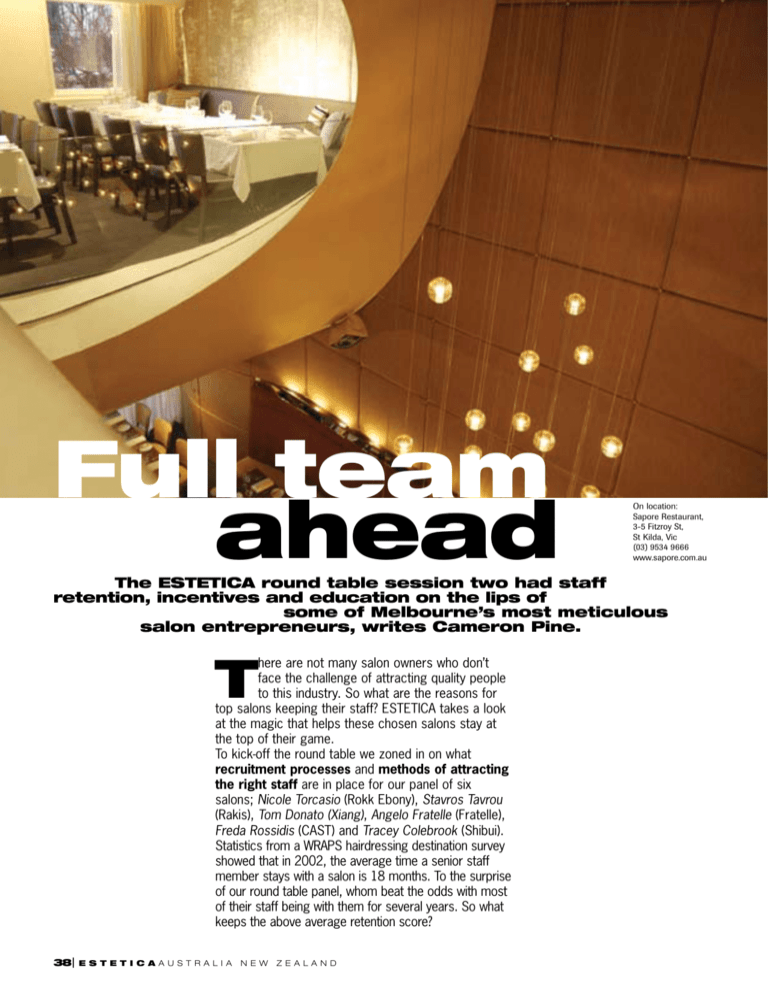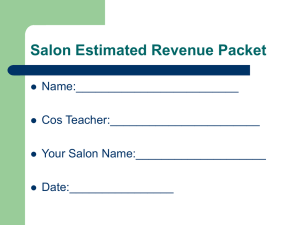Full team - Gaining Outcomes GO
advertisement

Full team ahead On location: Sapore Restaurant, 3-5 Fitzroy St, St Kilda, Vic (03) 9534 9666 www.sapore.com.au The ESTETICA round table session two had staff retention, incentives and education on the lips of some of Melbourne’s most meticulous salon entrepreneurs, writes Cameron Pine. T here are not many salon owners who don’t face the challenge of attracting quality people to this industry. So what are the reasons for top salons keeping their staff? ESTETICA takes a look at the magic that helps these chosen salons stay at the top of their game. To kick-off the round table we zoned in on what recruitment processes and methods of attracting the right staff are in place for our panel of six salons; Nicole Torcasio (Rokk Ebony), Stavros Tavrou (Rakis), Tom Donato (Xiang), Angelo Fratelle (Fratelle), Freda Rossidis (CAST) and Tracey Colebrook (Shibui). Statistics from a WRAPS hairdressing destination survey showed that in 2002, the average time a senior staff member stays with a salon is 18 months. To the surprise of our round table panel, whom beat the odds with most of their staff being with them for several years. So what keeps the above average retention score? 38 ❘ e s t e t i c a a u s t r a l i a n e w z e a l a n d r o u n d “Everyone has a good day whenever you have a meeting.” Freda Rossidis. t a b l e and link any enquiries to your website. Advertising on a large scale may attract up to 100 candidates, of which only 30 per cent can be quality applicants. On average, how long do you keep team members? Most agreed that due to their strong brand awareness, they are often approached by seniors from other salons although apprentices often come through advertising on websites such as Seek. It was a fair point in agreeance by all that sometimes you just need to give them a go under the usual 3 months probationary period - you can’t always tell what people are capable of until they get comfortable. Some salon owners also prefer to work with someone who is fresh and ready to learn, a blank canvas that they can grow into the brand. Presenting well and a strong personality are also ideal character traits. One salon owner mentioned that it’s a great idea to go and have a coffee, reinforcing the ethos that if you can sit down and get along with them as a person then you can generally work with them. Other recruitment methods include: • Keeping in touch with hairdressing colleges. • Profile building: profile is the biggest drawcard. • A long history and strong brand recognition also helps. • Ask team members to be on the lookout for likeminded individuals. • Heavily research the demographic you are trying to attract. • Look for students who are just about to finish a hairdressing course. • For management staff; personality, organisation abilities and trust are key points that salon owners need from management staff. Advertising process; Do you advertise, how effective is this? Some agreed that you are best to advertise directly to reputable hairdressing colleges. The best candidates tend to be the students that have committed to the 12 month hairdressing courses. Salonscout.com was also suggested as it can often attract better quality candidates than Seek. Also use your own website to advertise or advertise in the paper Generally you can identify if someone isn’t right within the 3-6 month period and at that point you can initiate their departure. The general consensus was that there is a turnover in the first 12 months. Apprentices usually stay for around two years after their apprenticeship, Seniors with varying averages from 4-5 to up to 10-15 years. Most of the six are fortunate that staff have only left the salon to travel, for family commitments or to relocate – not to other businesses. “Your business values stay the same, but they progress, so as long as you move with the times and are aware of what they like, offer career paths and education to keep them stimulated, you will keep your staff.” What strategies do you have in place to retain your team? Systems and processes that maintain consistency, performance reviews and aspirational career paths are important. Offer them additional education so they are constantly developing and creating. Start training immediately and appoint one apprentice to another to mentor each other. Have regular meetings/weekly appraisals with staff – make it friendly and relaxed. Don’t frighten them off with intense induction programs. What is the process/exit strategy for when an employee leaves? (How are reasons identified and explained) Salon managers or owners are generally responsible for the exit strategy. Similar to the probationary period, with a large business, initiate weekly discussions and appraisals. Incentives (wages, bonuses, salary packages, employment) This is an aspect that must be presented and discussed immediately, you need to make them aware at the time of employment. As a general consensus, money doesn’t appear to be an incentive, travel and flexibility is. Over the course of the employment you quickly learn what is going to press their buttons. Some determine their potential employees by showing them their salon structure, and if they don’t like it or don’t seem to connect with it then they are not hired. What incentives are in place? In some salons, targets are set and monitored weekly, each person’s productivity is measured and set against a weekly target. Others set a group salon target to encourage the team to reach the level together. Others offer a Christmas bonus, travel incentives and holidays including accommodation etc. Apprentice incentives are generally not financial based, they are opportunity based or bonus training based. Younger staff love the opportunity to work at shows, photoshoots, backstage and public recognition is one of the best incentives for them. 40 ❘ e s t e t i c a a u s t r a l i a n e w z e a l a n d Dinner vouchers, gold class movie tickets are also a great way to broaden the experience of staff. One salon owner chooses to take staff to nearby up-market restaurants so they can connect with the client base and offer restaurant suggestions that suit savvy clients. Incentives are kept fair by having a standardised program for all staff. Some also believe that constant training and overtime pay is an additional incentive for staff. The effectiveness of incentives is agreed by all salons that they are designed to encourage a consistent high work ethic which in turn benefits the employee immensely. What do staff want today? A good work environment, fairness, acknowledgement and respect. These aspects are usually made clear in the interview once the staff member or potential staff member is also fully aware of their responsibilities. A work/life balance was one of the most significant points in the discussion. Employers now recognise the need to be flexible with working hours for working mothers, understand the needs of how generation Y live their life so their schedule can meet their needs, motivate them and allow them to work at their peak. Being flexible is one of the biggest advantages for employees. What management systems are in place to motivate team members? You need to empower staff with the power of your brand so everyone can understand and follow the brand’s philosophy. Creative people are motivated by lifestyle benefits and external opportunities generally. If your salon has a good history and a recognised system in place you will always get people wanting to buy-in to the team or salon environment. Photoshoots and public recognition are great motivators. Newsletters internally and recognition among other staff are also good incentives for motivation. Staff meetings help motivation. One example is to get staff to say something nice about another staff r o u n d t a b l e “Hairdressing is heavily managed. I can be a little anti-managers although apprentices need mentors and guidance. Our history and brand power is our biggest asset.” Tracey Colebrook From left; Tom Donato, Freda Rossidis, Stavros Tavrou member every Saturday morning. This encourages camerarderie in the salon. Incident reports that can be given to management confidentially also help staff to understand they can be listened to. Staff want to be listened to. Try to avoid behind closed doors chats, instead keep the communication open so everyone is aware of the expectations across the board. Every junior staff member should have a mentor in the salon. Do you grow your own people and how? Allow your staff to be leaders regardless of their status. Have them market a product, to encourage product knowledge and confidence. Have a salon philosophy and ensure staff understand it and work by it. Staff must firstly understand how to live the brand when they are in the salon environment. Some have weekly assessments of 10-15 minutes to ensure they are happy and motivated. A good rule is to give praise in public and criticize in private. This will allow staff to grow with your core business and feel confident to take on further responsibility within the salon, whether it be a coordinator, promotion to a manager, or head colourist. How do you develop a personality (culture/philosophy) within the brand? Use an in-house manual and policy and procedures system that mimics your brand values and passes down the history of the brand. Salon culture should be crystal clear when people walk in the door. Talk about your values and philosophies at the recruitment stage, you can generally guage whether staff will adapt to this from their reaction and enthusiasm. Part of the induction process should be spent on the floor being exposed to the culture. What education or training systems do you have in place to inspire junior staff? One particular salon recognises the potential of an employee in a particular area once they are nearing the end of their study and offers education incentives and room for advancement in this particular area. A tiered mentor system is a reliable way to keep education levels high. Weekly training is standard but some salons offer more or additional one on one training. 42 ❘ e s t e t i c a a u s t r a l i a n e w z e a l a n d One on one training – encourage an open forum, clients appreciate the salon openness. Another salon starts their training from day one, three weeks out of every month involves regular sessions which evolves based on their level. Educating staff culturally as well as professionally is also a key point – take staff to art galleries, restaurants and bars and allow them to be inspired. Address every member’s needs individually and on a weekly basis at management level. Use suppliers and make them accountable for staff training, although this should not replace individual training. Choosing the right mentor is half of the job’s success! What does your salon’s management structure look like, what are the qualities and necessary incentives? All agreed that a clear structure, strategy and guidelines must be adhered to at all times, however, the strategy must continuously be refined and developed. Managers must have leadership skills and be able to relate to the staff and most importantly have the ability to understand different personalities. They also need to be able to resolve conflict and provide guidance. You can’t always bring a manager in, you must develop them internally. There is more mentoring needed in a salon than managing. If you have more than one salon it was recommended that it is best to have more than one business partner. A typical organizational chart may look like: MD-HR Manager, Education Directors, Financial manager, Salon manager, Salon coordinators, team leaders and apprentices. Management team incentives include a partnership that rewards longevity and loyalty. In saying that, some staff are stars and get there quicker by really working the salon culture, values and philosophy. Many thanks to our round table partner, L’Oreal Professionnel for their support in launching this platform to encourage networking and salon development. A further thank you to our facilitator Terry-Lyn Stevens and all of our Melbourne salon owners for their input. r o u n d t a b l e From left: Tanna Colebrook, Tracey Colebrook, Nicole Torcasio, Angelo Fratelle “I usually favour apprentices who have been brought up by parents who have their own business or worked for themselves. Their work ethic can be different if they have come from a hard-working background.” Tracey Colebrook







